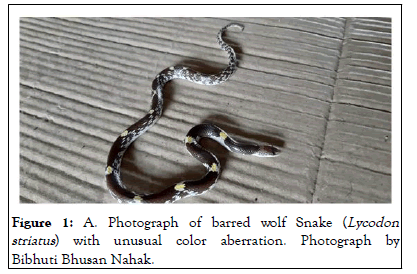Entomology, Ornithology & Herpetology: Current Research
Open Access
ISSN: 2161-0983
ISSN: 2161-0983
Short Communication - (2022)Volume 11, Issue 6
Body patterns in snakes vary as per the species, geographical location, and adaptive requirements of species and it is created by the presence of different pigments in the skin. The patterns tend to provide various functions from basic to more specific ones. The barred wolf snake is one of the snakes showing morphological color patterns and is often used for its identification purpose. Color aberration in snake is observed as common-phenomena. Here in, we have documented a unique aberration in the barred wolf snake.
Non-venomous colubrid; Rescue; Thermoregulatory advantages; Documentation; Adaptation
Animal coloration is important in several aspects of animal ecology. It is significantly important for cold blooded animals like amphibians and reptiles, where some color anomalies may exist a thermal biology effect, in addition to survival and ecology. Snakes are distinguished based on the visual morphological features such as body coloration, size, arrangement of patterns, stripes.
Snakes can be blue, green, brown, or purple despite having a limited set of pigments (black, red, yellow, plus reflections by iridophores). These hues result from variations in quantity, quality, and interaction of the primary colors, the various spectrum components refracted by iridophores, and the hemoglobin in the dermis's blood supply Chromatophores present in the body are responsible for imparting a specific coloration to the skin. Common Snake patterns includes stripes, crossbands, neck rings, rings on the body, chain marking, longitudinal rows of dorsal blotches or saddles, longitudinal rows of diamond-shaped markings, and spots and checkers on the venter [1-5].
Species belonging to the suborder Serpentes provide an effective model for comprehending the processes involved in visual signal design. Although snakes' vision is generally poor, they are frequently both predators and prey to visually oriented species. Color aberration in snakes and birds are a common biological phenomenon relative to vertebrates. Anomalies of this nature may be crucial to our comprehension of ecological species history or phenotypic plasticity.
Colors and patterns of snakes can provide concealment, mimicry, thermoregulatory advantages, or act as warning signals. Conspicuous deviations from the typical skin color of a given species are widespread in the animal kingdom, including examples of excessive and reduced pigmentation. Herein for the first time, we document an unusual morphological aberration in head of the common Barred Wolf Snake (Lycodon striatus) in Angul district of Odisha, India. Unusual body coloration has been previously documented in common-wolf snake.
The Barred Wolf snake is a non-venomous colubrid that ranges throughout much of peninsular India. The body is dark brown or black above, with white transverse spots or cross bands, which are widely separated anteriorly; the sides are lineolate with white and a black spot corresponding to each white cross band; upper lip and venter are uniformly white; the head is only slightly distinct from the neck; the snout is flattened; 8 upper labials, the first and second in contact with the nasal [6-14].
On 26 March 2019, we received a rescue call from Angul, Odisha, India (20.9104185°N, 85.1788185°E). Upon arrival, we spotted a L. striatus having an unusual color in the head region (Figure 1). Based on the classified taxonomical features of the colubridae family and previous records we identified the snake.

Figure 1: A. Photograph of barred wolf Snake (Lycodon striatus) with unusual color aberration. Photograph by Bibhuti Bhusan Nahak.
This is a rare documentation of this phenomenon from Odisha. Although, the morphological variations tend to be more frequent in cold-blooded animals with a high evolutionary rate and adaptability towards the environment compared to mammals.
After photographing the snake, it was relocated into its natural habitat. We consider it as a first photographic record of a color aberrant barred wolf snake from Odisha and the reason for this unusual morphology is unknown. Our snake rescue team created a small awareness session in the village after the rescue process. In this awareness session our team explained that, snake was non-venomous and not dangerous to our major target audience, the children and the local communities who were initially afraid of the snake. Awareness and outreach programs help in getting support from local communities towards achieving a significant goal of conservation.
We thank the snake rescue team members of Angul for carrying out many major Snake rescue operations and maintaining harmony among people and snakes and the Earth Crusaders Organisation for literature and helpful comments on a draft of this manuscript.
The authors declare no conflict of interest during the preparation of this article.
Citation: Sahu JS, Nahak BB, Samal A, Maharana S, Pandey S (2022) Aberrant Head Coloration in a Barred Wolf Snake, Lycodon striatus (Shaw 1802), from Odisha, India. Entomol, Ornithol Herpetol. 11:293.
Received: 15-Jul-2022, Manuscript No. EOHCR-22-18419; Editor assigned: 18-Jul-2022, Pre QC No. EOHCR-22-18419(PQ); Reviewed: 01-Aug-2022, QC No. EOHCR-22-18419; Revised: 11-Oct-2022, Manuscript No. EOHCR-22-18419(R); Published: 18-Oct-2022 , DOI: 10.35248/2161-0983.22.11.293
Copyright: © 2022 Sahu JS, et al. This is an open-access article distributed under the terms of the Creative Commons Attribution License, which permits unrestricted use, distribution, and reproduction in any medium, provided the original author and source are credited.